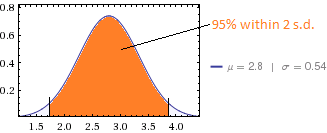Short answer, it's fine and a bit lower than I might have expected from survey data. But probably your business story is more in the mean or the top-2-box percent.
For discrete scales from social science research, in practice the standard deviation is a direct function of the mean. In particular, I have found through empirical analysis of many such studies that the actual standard deviation in surveys on 5-point scales is 40%-60% of the maximum possible variation (alas undocumented here).
At the simplest level, consider the extremes, imagine that the mean was 5.0. The standard deviation must be zero, as the only way to average 5 is for everyone to answer 5. Conversely, if the mean were 1.0 then the standard error must be 0 as well. So the standard deviation is precisely defined given the mean.
Now in between there's more grey area. Imagine that people could answer either 5.0 or 1.0 but nothing in between. Then the standard deviation is a precise function of the mean:
stdev = sqrt ( (5-mean)*(mean-1))
The maximum standard deviation for answers on any bounded scale is half the scale width. Here that's sqrt((5-3)(3-1)) = sqrt(2*2)=2.
Now of course people can answer values in between. From metastudies of survey data in our firm, I find that the standard deviation for numeric scales in practice is 40%-60% of the maximum. Specifically
- 40% for 100% point scales,
- 50% for 10-point scales and
- 60% for 5-point scales and
- 100% for binary scales
So for your dataset, I would expect a standard deviation of 60% x 2.0 = 1.2. You got 0.54, which is about half what i would have expected if the results were self-explicated ratings. Are the skills ratings results of more complicated batteries of tests that are averages and thus would have a lower variance?
The real story, though, is probably the ability is so low or so high relative to other tasks. Report the means or top-2-box percentages between skills and focus your analysis on that.


